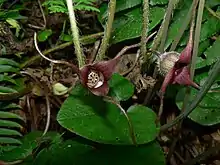Asarum caudatum
Asarum caudatum (British Columbia wild ginger, western wild ginger, or long-tailed wild ginger) is native to rich moist forests of western North America from British Columbia to California and as far east as western Montana. It is an evergreen with flowers that develop from March to August. The flowers are distinct, hirsute (hairy), cup-shaped, and brown-purple to green-yellow which terminate in three, long, gracefully curved lobes, often concealed by leaves. The long rhizomes give rise to persistent reniform (kidney/heart shaped) leaves. Leaves are found in colonies or clusters as the rhizome spreads, forming mats.[3] The leaves emit a ginger aroma when rubbed.[4]
| Asarum caudatum | |
|---|---|
 | |
| Scientific classification | |
| Kingdom: | Plantae |
| Clade: | Tracheophytes |
| Clade: | Angiosperms |
| Clade: | Magnoliids |
| Order: | Piperales |
| Family: | Aristolochiaceae |
| Genus: | Asarum |
| Species: | A. caudatum |
| Binomial name | |
| Asarum caudatum | |
| Synonyms[2] | |
| |
Etymology
Caudatum comes from the Latin cauda meaning tail. This refers to the tail-like shape of the flower's calyx.
Ecology and distribution
Asarum caudatum is found in British Columbia, Washington, Oregon, Northern California,[5] Idaho, and Montana[3] in moist, shaded environments. It is a typical herb found in the understory of mixed conifer forests under 2,200 feet in elevation, and is often a dominant plant.[6][7] It reproduces rhizomatously, meaning many mats are formed by one clonal plant connected by a rhizome. A. caudatum can also reproduce sexually, with its seeds dispersed by ants. Their flowers are pollinated by flies. However, cross-pollination is rare. Ants are attracted by a fatty appendage attached to the seed.[8]
The ants carry the entire package back to their colonies. The seed is often dropped outside the nest once the ant realizes only the appendage is edible. Due to the costs of producing seeds with an appendage to attract ants, it is more energetically favorable for the plant to reproduce rhizomatously.
Uses
The root is edible.[9] Native Americans used the plant for various medicinal purposes.[9]
Some describe using A. caudatum as a ginger substitute and as a tea with medicinal properties. Members of the family Aristolochiaceae contain aristolochic acid, which has been recognized as a carcinogen.[10] In a study on its effects on fungus, A. caudatum had antifungal properties when tested against nine fungal species.[11]
Conservation
Asarum caudatum is not listed a species of concern. However, the habitat in which it is native is threatened in some regions by logging and other land uses.
References
- "Asarum caudatum". NatureServe Explorer. NatureServe. Retrieved 2007-12-15.
- The Plant List: A Working List of All Plant Species, retrieved 5 March 2016
- Whittemore, Alan T. ; Mesler, Michael R.; Lu, Karen L. (2006). "Asarum caudatum". In Flora of North America Editorial Committee, eds. 1993+ (ed.). Flora of North America. 3. New York & Oxford: Oxford University Press.
- US Forest Service Fire Ecology
- "Calflora: Asarum caudatum". Calflora. Retrieved 1 March 2016.
- "Plant Propagation Protocol for Asarum caudatum" (PDF). University of Washington. Retrieved 2 June 2015.
- Mesler, Michael R.; Lu, Karen. "Asarum caudatum". Jepson eFlora. Retrieved 2 June 2015.
- "Wild Ginger". Evergreen.edu. The Evergreen State College. Archived from the original on 25 September 2006. Retrieved 2 June 2015.
- Fagan, Damian (2019). Wildflowers of Oregon: A Field Guide to Over 400 Wildflowers, Trees, and Shrubs of the Coast, Cascades, and High Desert. Guilford, CT: FalconGuides. p. 143. ISBN 978-1-4930-3633-2. OCLC 1073035766.
- Schaneberg, B. T.; Applequist, W. L.; Khan, I. A. (2002). "Determination of aristolochic acid I and II in North American species of Asarum and Aristolochia". Die Pharmazie. 57 (10): 686–689. PMID 12426949.
- McCutcheon Towers, A. R.; Ellisa, S. M.; Hancock, R. E. W.; Towers, G. H. N. (1994). "Antifungal screening of medicinal plants of British Columbian native peoples". Journal of Ethnopharmacology. 44 (3): 157–169. doi:10.1016/0378-8741(94)01183-4. PMID 7898123.
External links
 Media related to Asarum caudatum at Wikimedia Commons
Media related to Asarum caudatum at Wikimedia Commons- Roché, Cindy Talbott; Lang, Frank A. "Green-flowered Wild Ginger" (PDF). Native Plant Society of Oregon. Retrieved 2 June 2015.
- Profile at USDA PLANTS Database
- Distribution Map from Flora of North America at efloras.org
